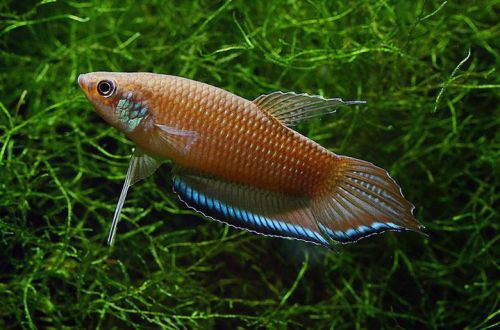
Ladigesia Roloff
Ladigesia Roloff, scientific name Ladigesia roloffi, belongs to the family Alestidae (African tetras). One of the least common Tetra species in the wild due to habitat destruction. Home and commercial aquariums will soon become the only place where they will be kept. Miniature beautiful fish do not cause great difficulties in keeping, if the necessary hydrochemical conditions are maintained.

Contents
Habitat
The natural range of habitat is not precisely established, but large populations were found in the territory of modern Sierra Leone (West Africa). It lives in small streams and rivers flowing among tropical rainforests. However, at present, 97% of the primary forest cover has been destroyed for plantations, so Roloff’s Ladigesia is on the verge of extinction and has survived only in small protected reserves.
Brief information:
- The volume of the aquarium – from 60 liters.
- Temperature – 20-26°C
- Value pH — 5.0–7.0
- Water hardness – soft (1-8 dGH)
- Substrate type – any sandy
- Lighting – subdued
- Brackish water – no
- Water movement is weak
- The size of the fish is up to 3 cm.
- Food – any food
- Temperament – peaceful
- Keeping in a flock of at least 10 individuals
Description
Adults reach a length of only 3 cm. The color of the body is silver with bright red caudal and dorsal fins. Sexual dimorphism is weakly expressed, it is very difficult to distinguish a male from a female. Only during the mating season, by the belly swollen from caviar, it is possible to determine the female.
Food
It feeds on tiny invertebrates and other zooplankton. The aquarium will accept dry food of a suitable size in combination with frozen or live daphnia, brine shrimp, grindal worms, moina, etc.
Maintenance and care, arrangement of the aquarium
A flock of 10 fish will need a tank of 60 liters or more. The design uses a sandy substrate with a few decorative snags for shelter. Lighting is subdued, floating plants will additionally scatter light. Rooting plants are arranged in groups, forming small thickets. The aquarium must have a protective cover to avoid accidental jumping of fish.
Adding fallen tree leaves to the bottom will accentuate the natural look and provide a source of tannins and other chemicals present in the natural habitat. Before adding the leaves, they are pre-dried, then soaked in containers until they begin to sink, and only then placed in the aquarium. All leaves are replaced every 1-2 weeks.
Pay special attention to water conditions. Ladigesia Roloff needs very clean and soft slightly acidic water. Regularly remove organic waste (feed leftovers, excrement, etc.). Use a performance filter with peat-based filter media. At least once a week, renew part of the water in the aquarium (15-20% of the volume) with fresh water, which is desirable to pass through a reverse osmosis system.
Behavior and Compatibility
Peaceful active schooling fish (buy at least 8-10 individuals) that could keep company with other species of similar size and temperament, however, high water quality requirements impose their own restrictions on the selection of neighbors. When kept with other fish, it will be necessary to double the size of the tank or more. In large volumes, the likelihood of reaching dangerous levels of organic waste pollution is much lower.
Breeding / breeding
Successful examples of breeding Ladigesia in home aquaria are rare for various reasons. Spawning should be carried out in a separate tank with a volume of 20 liters or more, the bottom of which is covered with a layer of peat and covered with a fine mesh in order to protect eggs from being eaten by adult fish. Use special peat from pet stores, where it is supplied already processed and disinfected. There is no need for formalization. The lighting is subdued, often without separate lamps, there is enough light coming from the room. Of the mandatory equipment – a heater and an airlift filter. It is filled with water from the main aquarium shortly before the start of spawning.
The incentive for the beginning of the mating season is a change in diet, the basis of the daily menu is live food. The temperature rises to the maximum allowable mark of 25-26°C. When the females are noticeably rounded, they, along with several males, are placed in a separate aquarium. Some time later, at the end of spawning (when the females “lose weight”), the fish are returned back.
The fry appear in 24-36 hours, within a week they will begin to swim freely in search of food, feed them with microscopic food for juvenile aquarium fish.
Fish diseases
The well-being of Ladigesia Roloffa is directly affected by the conditions of detention. Inappropriate water parameters, high levels of organic pollution, poor nutrition will not slow down the health of the fish – the main sign is the loss of the red color of the tail and dorsal fin. In this case, be sure to bring all the indicators back to normal. If other symptoms appear, see the treatment recommendations in the Aquarium Fish Diseases section.





